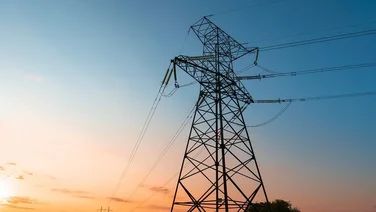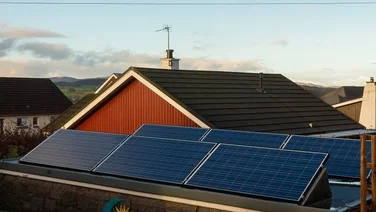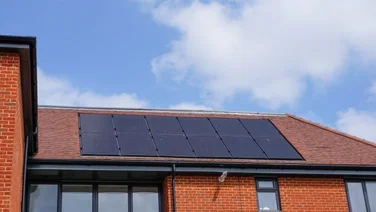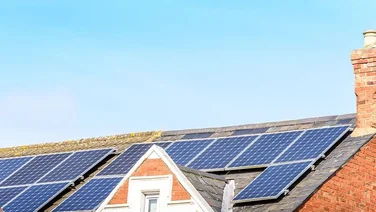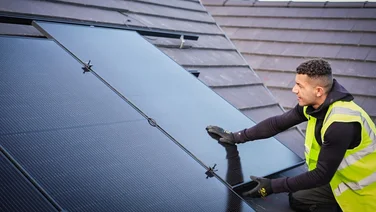- The average 1/2-bedroom home needs 6 solar panels
- The average 3-bedroom home needs 10 solar panels
- Your electricity usage will determine how many solar panels you need
- The more efficient your solar panels are, the fewer you’ll need

How many solar panels do you need for your home? (pic credit Solar Fast)
If you’re thinking about installing solar panels, the first question is usually, “How much do solar panels cost?” Before you work this out, however, you need to understand how many solar panels you need for your home – and the answer will depend on a number of factors:
The main considerations are:
- The size of your home
- Your annual electricity consumption (measured in kilowatt-hours or kWh)
- The efficiency of the solar panels you intend to have installed
- How many hours of daylight you get where you live
The more you add, the higher the cost, so it’s important to strike the right balance to actually meet your needs.
But don’t worry, you don’t need to be an expert in all of this to work out how many panels you’ll need. Your solar panel installer will do the hard parts for you, but here’s a rough guide based on the size of your house:
| Household size | Solar PV system | Number of 350W panels | Roof space | Annual energy output | Average cost |
|---|---|---|---|---|---|
One-bedroom flat | 1 kWp | 3 | 6 m² | 790 kWh | £2,358 |
1-2 bedroom house | 2 kWp | 6 | 12 m² | 1,590 kWh | £4,716 |
3 bedroom house | 3.5 kWp | 10 | 20 m² | 2,645 kWh | £7,860 |
4-5 bedroom house | 5 kWp | 14 | 28 m² | 3,700 kWh | £11,005 |
If you’d like an estimate, fill in our solar panel calculator tool below to help you work out:
- How many solar panels you’ll need
- How much your installation is likely to cost
- How much you’ll be likely to save on your annual energy bills
- How quickly you’ll break even on your solar investment
You can also connect with our trusted suppliers, who will get in touch with a quote.
This guide includes everything you need to help you accurately calculate the number of solar panels you need for your home.

Get free solar panel quotes
Answer a few quick questions, and our trusted installers will send you bespoke solar panel quotes – for free.
How many solar panels do you need for your house?
The average one-bedroom house needs six solar panels, a typical three-bedroom house requires 10 panels, and a five-bedroom house will usually need 14 panels.

In each case, the panels will produce enough power to cover 49% of the average household’s annual electricity usage – or more, if you don’t leave the house very often and use less electricity.
Annual electricity usage is measured in kilowatt hours (kWh). 1 kWh is how much electricity it would take to run a 1,000 watt (1 kW) appliance for an hour – so, for example, if you had a 500 watt dishwasher, you would use 0.5 kWh in an hour of use.
Without a solar battery, around half of the electricity your panels produce will go unused by your home, because you won’t always be there to use it when it’s generated.
Not to worry, though – you can sell this extra power back to the National Grid via the Smart Export Guarantee (SEG).
The savings you’ll gain from the SEG and from not having to pay for expensive National Grid electricity mean you’ll typically break even in 15.66 years, according to our calculations — making solar panels a good investment for most homeowners.
What factors influence the number of solar panels a home needs?
Here are the top considerations you should make when deciding how many solar panels to buy for your home:
- The number of people in your home
- Geographic location
- Direction and orientation of your roof
- Available ‘useful’ roof area
- Construction and quality of roof
- Type of solar panels
- Solar panel efficiency
- Other factors
The number of people in your home
Although the size of the house is normally the main factor in working out the number of panels you’ll need, the number of people who live in your home will also affect your electricity usage and can affect the number of solar panels you need.
For example, a large four-bedroom home with only two full-time occupants, might only need six to 10 solar panels instead of 14, as fewer people will be using electricity.
Here’s an overview of how many solar panels you need per person:
- One to two people: six solar panels
- Two to three people: 10 solar panels
- Four to five people: 14 solar panels
- Over five people: 16+ solar panels
House size still plays a large role in determining how many solar panels you need, too, since a large house will still use more electricity than a small house, even if there aren’t many people in it.
That’s why it’s best to base how many solar panels you need on your electricity usage, as this will give you the most accurate estimate.
Geographic location
The location of a property determines how many hours of sunshine you’ll get and, as a result, how much electricity the solar panels will generate.
Solar panels still work on cloudy days but they produce more electricity in direct sunlight. So, if you live in an area that doesn’t get a lot of sun, you might want to install more solar panels (if you can fit them).
Let’s look at an example. A property with a set of 10 350 watt (W) solar panels would produce around 2,978 kilowatt hours (kWh) of electricity a year in southern England. The same system would produce 2,221 kWh in northern Scotland.
To achieve the same result with solar panels in Scotland as you would in southern England, you’ll typically need one to three more panels.
Direction and orientation of roof
In the UK, the best orientation for solar panels is facing south. This exposes them to the most hours of sunlight, which means they produce more electricity than panels that face east, west or north.
According to Endesa, solar panels on east-or west-facing roofs produce 20% to 30% less energy than those on south-facing roofs.
If you have an east- or west-facing roof, you might need to install one to three panels to achieve the same energy production.
Solar panels on a north-facing roof, on the other hand, will be exposed to less direct sunlight, and produce less electricity. This will make it much less profitable to get panels, as you might have to get more (if you can fit them) to make up for this.

Get free solar panel quotes
Answer a few quick questions, and our trusted installers will send you bespoke solar panel quotes – for free.
Available ‘useful’ roof area
A complex roof (different pitches, cross-gables, etc.) or a roof with many obstructions (such as chimneys) can limit the number of solar panels you can install. Therefore, if you’re short on unobstructed roof space, you may be forced to use fewer solar panels.
Construction and quality of roof
If your roof is old or in poor condition, this may also affect the number of solar panels your house can handle. This is because the additional weight of the panels can place strain on roof structures and potentially cause damage as a result.
If you’re concerned about the quality of your roof, we’d recommend using monocrystalline panels as they’re able to produce more power from a smaller area, or thin-film panels due to their lighter weight and flexibility.
Type of solar panels
Each type of solar panel has an efficiency range, which refers to the percentage of sunlight a panel is able to convert into electricity. Panels with lower efficiency produce less energy, so it’s worth being mindful of their range if you want to maximise energy output.
The two main types of solar panels used in residential installations are monocrystalline and polycrystalline panels. Polycrystalline panels are 13%-16% efficient on average, while monocrystalline panels are 18%-24% efficient.
This means that if you’re installing polycrystalline panels, you’ll need more of them to achieve the same results as you would with monocrystalline panels.
Efficiency of solar panels
If you choose solar panels that are highly efficient, you’ll need fewer of them to meet your energy needs. This is because the more efficient a solar panel is, the more energy it will produce.
While solar panels are 20% efficient on average, some models have achieved 24% efficiency. So, if you’re considering getting solar panels that are 24% efficient, you might need fewer of them. Be aware, though, that the more efficient a solar panel is, the more expensive it tends to be.
Other factors
The number of solar panels you use could also depend on other factors, including shading from nearby buildings, trees, chimneys and local permitting/listed building/protection area restrictions.
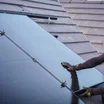
Get free solar panel quotes
Answer a few quick questions, and our trusted installers will send you bespoke solar panel quotes – for free.
Calculate the number of solar panels you need
Work out the number of solar panels you need by finding out how much electricity you use per year, then divide that figure by the yearly output of a solar panel – in the UK, that’s around 265 kWh per year for a 350-watt panel.
Here is the formula:
Annual electricity usage (in kWh) ÷ 265 (kWh)
To make this step even easier, we’ve done the hard work for you.
Just fill in the solar panel calculator at the top of the guide with your number of bedrooms and where you live, and we’ll tell you how many solar panels you’ll typically need.
The calculator is meant to give you a general idea of how many solar panels you need, but there are several factors that can affect this.
If you want to do this manually (to sense check our calculator), these are the steps you need to follow:
- Calculate your annual electricity usage
- Work out the number of panels needed
- Calculate how big your roof is
Which solar products are you interested in?
Get started
1. Calculate your annual electricity usage
The first step is to determine how much electricity you use yearly.
You can find out how much electricity you use by checking your energy bills.
If you don’t have an annual summary or the past 12 months’ bills, contact your supplier to get the figure.
If you don’t have an annual summary or the past 12 months’ bills, contact your supplier, and a representative will let you know your yearly total in kilowatt-hours (kWh).
Compare your electricity usage with the table above to get a rough idea of how many panels you’ll need to generate roughly the amount of electricity you use each year.
For context, a three-bedroom house typically uses 2,700 kWh per year, according to Ofgem. Here’s a rough overview table of what you should expect to see.
| Property size | Annual energy consumption | Estimated number of solar panels needed
(based on 350W) |
Estimated number of solar panels needed
(based on 450W) |
|---|
Solar PV system size | Number of solar panels | Surface area |
|---|---|---|
1 kWp | 3 | 6 m² |
2 kWp | 6 | 12 m² |
3.5 kWp | 10 | 20 m² |
5 kWp | 14 | 28 m² |
*based of the average solar panel size of two square metres.
Most residential solar panels measure around 2 square metres and are rectangular.
They’re usually about 2 metres long and 1 metre wide, and they have a thickness of 3-5cm.
The largest residential solar panels are as big as 3.1 square metres. Companies like Risen Energy produce panels this size that can generate up to 670W – around twice as much as a typical panel – which makes sense considering its size.
However, large panels aren’t necessarily any more efficient, and it can be complicated to fit them around obstacles on your roof, but they can look neater and more uniform.
The smallest solar panels are around 0.5 square metres, although these are typically reserved for leisure vehicles like caravans and boats.
If you’re looking for something particularly compact, check out:
- Sharp’s 258.4W NQ-R Series, measuring 1.29 square metres
- Panasonic’s HIT N340, measuring 1.7 square metres
You can also get around the issue of limited roof space with high-efficiency solar panels.
These premium panels are particularly good at converting sunlight into electricity, which means you might be able to get away with having fewer panels.

3. Find out how big your roof is
You’ll need to know you have enough roof area to actually accommodate the solar panels. Check your building plans or hire a professional to measure your roof to see if you can fit the number of solar panels you need.
If your roof is on the small side, don’t worry – you may be able to use fewer panels that all have a higher power rating. You can add solar panels to a shed or mount solar panels in the garden.
Considering these factors, you can roughly estimate how many panels you need — though, of course, a trained professional should give the final estimate.
If you want to receive free quotes from some of these trained professionals, just fill in this quick form.

Get free solar panel quotes
Answer a few quick questions, and our trusted installers will send you bespoke solar panel quotes – for free.
*Note that different brands may have varying dimensions for their solar panels, so it’s important to take this into consideration.
How heavy are solar panels?
Residential solar panels usually weigh between 18kg and 20kg.
That means a typical 10-panel solar array weighs more than two fully grown men, on average.
This is an excellent reason to hire a professional installer to get you all set up with solar power – along with the fact that they’ll install the panels properly.
If you’re buying solar panels for a vehicle or small off-grid building, you should consider flexible solar panels, which can bend around a corner or over a bump, and are also lighter, typically weighing in at between 0.8kg and 3kg.
Want to learn more? Head to our helpful guide How Much Do Solar Panels Weigh? for more information.

Get free solar panel quotes
Answer a few quick questions, and our trusted installers will send you bespoke solar panel quotes – for free.
| Solar panel output (W)* | Typical solar panel dimensions* | Typical weight per panel |
|---|---|---|
| 350 | 1.6m x 1m | 18kg |
| 400 | 1.67m x 1m | 18kg |
| 450 | 1.9m x 1m | 21.6kg |
Next steps
You’re now armed with all the information and practical advice you need to work out roughly how many solar panels you need for your home.
That means you’re ready to approach a solar professional, tell them your electricity needs and roof size, and have an informed conversation about how many panels you’ll require.
If you’re ready to see how much solar panels would cost for your home, just fill in this form to receive free quotes from our trusted suppliers.


